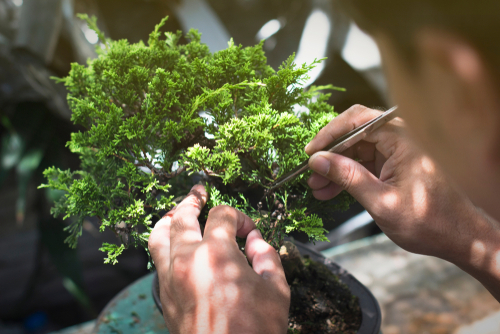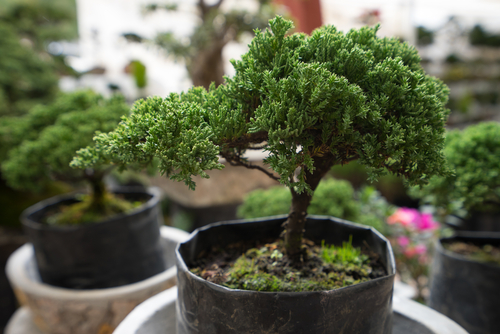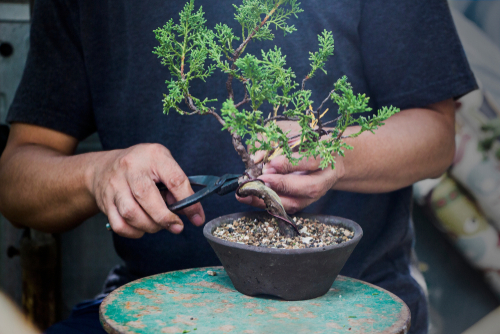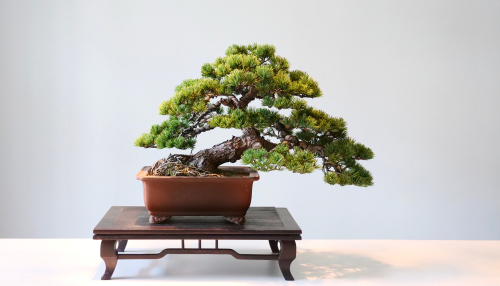A Beginners Guide to Cultivating and Growing your Own Bonsai Tree.
Curious about Bonsai trees, and if you have what it takes to grow one yourself? Read on!
Bonsai trees have been around for thousands of years, and some examples themselves can even be up to a thousand years old, so the art of selecting, growing, shaping, and displaying a Bonsai tree has earned the right to be called an ancient art form.
Whether you are just interested in Bonsai or want to try it out for yourself, here’s what you need to know, to get one to grow.

What IS Bonsai?
For one thing, Bonsai isn’t a species of tree in itself, it’s the name of the process. There are many different kinds of species of trees that make great Bonsai candidates, which we will cover later on in this blog.
The word Bonsai is also just a general term used to describe the Japanese take on the traditional Chinese art of penjing, and the word penzai, and can even be used to describe similar art forms found in Vietnam!
With Bonsai, the purpose of what you are doing is to simply create a miniature tree that’s pleasing to the owner and viewer, in contrast to penjing which also incorporates other scenic details and elements in a miniature landscape.
Dating back to the 6th century, the art of creating a very aesthetically pleasing, small tree in a pot is still very popular today, and here’s how to get started!
Choosing your Bonsai.
As we mentioned, there is no Bonsai tree per say, but there are Bonsai starts, mature trees, and very ancient ones too!
Not to be confused with dwarfing (which means breeding trees with small features together to result in a new variety or species itself) Bonsai starts include Ficus, Juniper, Japanese Maple, and others including cherry, wisteria, oak, and varieties of elm.
Full-size or Bonsai-sized, each species will require its own tending, care, and maintenance, so it’s important to know which species you have, or are planning on purchasing.

Which species should you choose?
With so many species to choose from, we could write a whole novel! But since you are likely just starting out, we will focus on the three most popular species for Bonsai, which are the Ficus, Juniper, and Japanese Maple.
Start by asking yourself how you would like your Bonsai to behave year-round.
Broadleaf evergreens (like the Ficus) will shed leaves gradually throughout the year, but you won’t experience seasonal shedding as with deciduous trees. Conifers, like the juniper, will keep their needly foliage all year long.
Next, where would you like your Bonsai to live? Ficus will want to live indoors, while junipers will prefer to live outside to thrive. The Maple will be hardier than the Ficus, but will still need some protection from severe cold, and the blazing sun.
How do I grow and care for my Bonsai?
As you may have guessed, growing, cultivating, and maintaining a Bonsai requires more thought and intervention than a regular potted plant.
There are many techniques that are used to create and maintain your tiny tree, in its tiny container including the following:
- Grafting new growing material (typically a bud, branch, or root).
- Defoliation, for short-term dwarfing.
- Deadwood bonsai techniques to create the appearance of age and maturity in your Bonsai.
- Leaf trimming, the selective removal of leaves, and or needles.
- Pruning the trunk, branches, and roots of your little tree.
- Wiring branches and trunks allows the bonsai designer to train and shape your tree.
- Clamping, using mechanical devices for shaping your branches and trunk.
These techniques aren’t a trial-and-error type of undertaking, so getting the proper mentoring, or education is essential when you acquire your Bonsai.
Luckily, there are tons of resources available, and there are also local Bonsai enthusiast groups right here in the Treasure Valley to help you get started, like the Boise Bonsai Society!

Since Bonsai’s are no ordinary plants, they are going to require a different care regimen than a full-size tree or a houseplant.
Here are some things to keep in mind.
- Watering: your Bonsai is going to require more frequent watering, due to the size of its container and root system. But overwatering can be deadly, so be careful.
- Tools: the wires, trimmers, and other devices that are used to shape and care for Bonsai are specialized.
- Repotting: repotting is best in spring, and should be personalized to the health and age of your tree.
- Location: your Bonsai will have its own light, temperature, and humidity expectations to survive and thrive.
- Soil and fertilizer: again, the Bonsai is special and will generally require loose, well-draining soil, and its own fertilizer regime.

How do I want my Bonsai to look?
If you are wanting to pay respect to tradition, or are desiring to get very serious about Bonsai, there are some aesthetic considerations to keep in mind.
- Asymmetry: it’s discouraged! The idea is for your Bonsai to appear as natural and untouched by human intervention as possible.
- No trace of the artist: your Bonsai should not look like you have cut, wired, shaped, or manipulated it in any way.
- Miniaturization: your Bonsai should appear as though it’s a perfectly normal, healthy full-size tree, but in miniature!
- Proportion among elements: proper miniaturization is all about proportions, and scale.
Are you interested in taking the next step? Taking an ancient art form and bringing it into your modern home is an exciting and satisfying undertaking!
We have new Bonsai starter kits and pots available in stock, today!
Or sign up for our Bonsai class!
